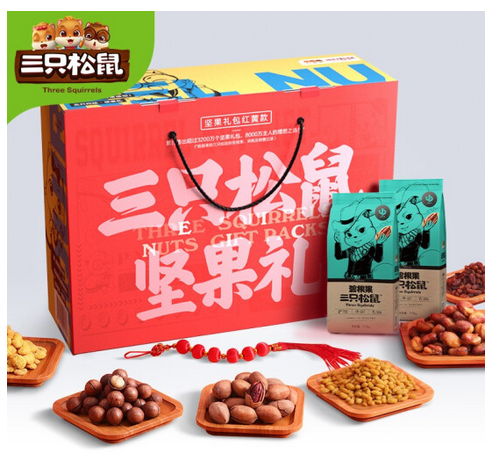In 2016, the Chinese television series Love O2O rose to popularity depicting a couple’s romantic vagaries in both the online and the offline gaming world. The show was a hit, and it also helped to catapult its highly visible sponsor, Three Squirrels, to greater fame, as the drama was peppered with unsubtle promotions of the company’s nuts, seeds, dried fruits, and other snacks.
Three Squirrels has grown into a billion-dollar company. As of December 2019, its annual sales exceeded RMB 10 billion (USD 1.4 billion), making it the first company in China’s snack food industry to surpass the double-digit billion mark in revenue. However, after a rapid rise, the Shenzhen-listed snack firm (300783) has ironically fallen victim to the vagaries of online to offline operations and is now struggling to find a sustainable growth model.

King of nuts
Deng Jie, a 24-year-old student, snacked heavily on Three Squirrels’ products growing up and remarked at not only the products’ flavor but the firm’s strong presence on online channels. “I don’t know why I keep buying it. I guess it is because is famous on Taobao? Everyone who has a phone knows what Three Squirrels is,” Deng said.
The company, founded in 2012, boasts over 38 million fans on its flagship Tmall store, while it claims to be the first Chinese snack food company positioning itself as a “pure internet brand”, Following two series of investments from IDG Capital and Capital Today in the earlier part of the decade, the company constructed its first factory in May 2012 and launched online operations just a month later.
A few reasons contributed to the firm’s rise. The company’s founder, Zhang Liaoyuan, found the right products for a fledgling brand to scale: packaged snacks with nuts and dried fruits, relieving pressure on logistics and distribution, compared to fresh foods. He also targeted a rising Chinese middle-class preference for healthy, gourmet snacks.
Yet, probably Zhang’s best decision was his willingness to fully commit to online retail as the brand’s main channel for sales and marketing, differentiating itself from offline competitors such as Baicowei and Laiyifen. While this decision may not seem novel ten years later, it was quite a risk in 2012. For perspective, only 160.5 million Chinese consumers shopped online in 2010, while today, that number is close to 800 million.
From its beginning, the company focused on marketing and brand-building, adopting an original equipment manufacturer (OEM) model for production, relying on upstream suppliers and downstream distributors for sales, effectively cutting out much of the dirty work and allowing the Three Squirrels to allocate more resources to research and development and marketing.
In 2016, it even trademarked and attempted to popularize a new festival in China, named “917 Nut Health Day” on September 17, following the success of other popular e-commerce shopping festivals such as Alibaba’s 11.11 and JD.com’s 9.18. However, the attempt never truly gained traction.
Besides promoting the brand on popular shows such as Love O2O and Ode to Joy, Three Squirrels also launched a 52-episode animated cartoon series, written by Carter Crocker of Barney and Winnie the Pooh fame. In 2017, it even launched a theme park in Anhui province, with the intention to create a local tourism hotspot.

A hard knock life
However, Three Squirrels’ time in the sun might be fading, precisely for what catapulted it to success. The firm, which managed a successful initial public offering (IPO) in July 2019 on the Shenzhen Stock Exchange after two failed attempts, has found a complicated market to overcome. Hefty marketing and operational expenditure across digital channels have squeezed margins, despite Three Squirrels ranking top in snack sales for seven consecutive years during China’s annual Single’s Day sales, including in 2020.
Its first annual report, released in April 2020, showed that despite a 45.3% year-on-year (YoY) growth in revenues, net profit decreased by 21.43% YoY. The company managed to turn its first profit of RMB 260 million (USD 38.7 million) in 2016 — but troublingly, its annual profits have remained in the same ballpark nearly four years later, generating just RMB 240 million in 2019. Investors started to raise concerns, and rightly so.
One of the problems affecting Three Squirrels is that although the internet has been a great leveler in allowing new internet brands to spring forth, the tables have now turned, as this asset-lite approach can be copied easily. Given the proliferation of competitors on other e-commerce platforms, Three Squirrels’ return on investment for its sales and marketing operations, which takes up the largest percentage of its operating expenses, is decreasing.
What’s more, Three Squirrels has also found an increasingly competitive market environment supported directly by its main partner, Alibaba’s Tmall marketplace, as the platform has been directly incubating other internet brands to extend its tentacles further into the e-commerce ecosystem, as part of Alibaba’s New National Products Plan, launched in 2019. Aside from Tmall, a whole new plethora of platforms, ranging from Douyin and Kuaishou to Bilibili, have become home to other niche brands challenging Three Squirrels’ market share.
The company’s rising marketing expenditure in the face of increasing competition is aggravated by Three Squirrels’ ambitious expansion into a full suite of product categories, in addition to nuts and dried fruit. With nearly 600 stock-keeping units (SKUs) and growing, the firm’s marketing spend is unlikely to decrease going forward.
Also, the brand has educated consumers from its launch to expect discounts — conditioning customers to be price-sensitive and limiting the company’s growth margins. “I wouldn’t buy their products if they didn’t offer a big coupon. They always run discounts…I go to them because they are cute and cheap,” said Deng.
Three Squirrels has encountered issues of quality assurance, as its inability to monitor the end-to-end production process is allegedly the source of some recent food safety problems affecting the company’s products.
In August 2017, China’s Food and Drug Administration found high levels of mold in its pistachio nuts, exceeding 1.8 times the acceptable standard. Caught between a rock and a hard place when it comes to increasing expenditure on marketing, or investing in greater oversight of its supply chain, Three Squirrels has some hard choices to make.
Forging ahead in the brick-and-mortar world
In an attempt to diversify, Three Squirrels has embarked on an aggressive offline expansion plan since the end of 2019. It has done so by piggybacking on various supermarkets, such as Alibaba’s Fresh Hippo. The company also inked a partnership with Chinese electronics retailer Suning to address offline distribution in Suning’s shops.
Three Squirrels continued its ambitious offline expansion by opening self-managed brick-and-mortar stores in lower-tier cities. The brand opened its first offline store in Wuhu’s Golden Eagle Retail’s shopping center in 2016, later eschewing metropolitan Shanghai for neighboring Suzhou for its next offline store in 2017.
In theory, establishing an offline presence could help the brand to cement its image as a provider of trusted, healthy, snacks, while it could also help with cross-selling higher-margin products, such as dried fruits and squirrel branded paraphernalia.
Currently, there are about 164 directly operated stores in operation, with an additional 785 franchise stores across the country — at first glance, unremarkable for a listed company, but an extraordinary leap considering that it only had 53 franchises and 12 directly operated stores a little more than a year ago in 2018. This illustrates a notable strategic shift for the snack brand that rose to fame through online channels.
Still, offline operations could represent a challenge as snack brand rivals Liangpin and Laiyifen already have a headstart with more than 2,000 offline stores each.
Additionally, managing offline operations is a whole different story. With sales revenue from offline stores only accounting for 8.9% of its total revenue, the firm’s administrative expenditure increased by 47.17% YoY, according to its annual report, pointing to managerial inefficiency.
Franchise management is also another problem. Screening potential franchisees for creditworthiness is also crucial, especially as Three Squirrels announced on October 28 its intentions to provide a loan line of up to RMB 300 million (USD 45.6 million) for new operators in an attempt to speed up its offline expansion. However, the move alerted regulators at the Shenzhen Stock Exchange due to the high financial risk involved for its shareholders.
As latecomers to this field, it remains to be seen whether its transformation will succeed. Is Three Squirrels doing is too little, too late?

